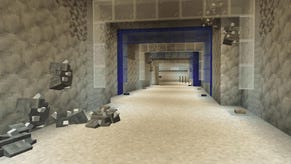Mavis Minecraft Teaches Coding – Part 3
30 GOTO 10
The man with wires in his brain, Duncan Geere, is here with the third part of our guide for learning programming with Minecraft. You can catch up with the whole series here.
Welcome to part three of the RPS guide to learning how to code in Minecraft. If you've been following the tutorials so far, you should have a decent grasp of the basics of coding - how to put programs together and what several different commands do.
This week, we're going to introduce something new to get your head around. The turtle. Turtles are autonomous moving computers with an inventory, basically the Minecraft equivalent of a robot helper. With their help, we'll be automating some of the duller functions of the game - chopping down trees and mining a dropshaft.
In the process, you're going to learn a few neat little coding tricks, including how to edit your programs outside of Minecraft itself. So what are we waiting for? Let's get started.
You'll need some more advanced resources in your inventory today. Twenty or so iron bars, a stack of coal, a chest, an unused diamond pick, and a stack of ladders and torches.
Once you've got all that, let's put a turtle together. Put a computer in the centre, a chest directly below it, and then fill out the rest of the spaces with iron bars. Something that looks a bit like this:
Plonk it down on the ground somewhere, and right-click to bring up the interface. You'll notice that it isn't quite running the same operating system as your regular computers, but don't worry - pretty much everything you've learned so far about operating computers in ComputerCraft will work.
The first thing you'll need to do is put some fuel in it. Drop a single bit of coal in the right hand side and type "refuel" in the command window. If you've done it right, it should return "Fuel level is 80". Turtles can mine and turn without fuel, but they need one unit of fuel for every block they move.
Now type "dance", hit enter, and then esc to dismiss the interface, and watch as your turtle gets on down. It'll carry on going until you right-click it and press a key, or it runs out of fuel.
Now, what can we usefully do with a turtle? Not a whole lot until we give it some tools, to be honest, except maybe automatically building a hut. But the code for that is a bit tedious, so let's skip that and go straight to mining turtles.
First, stick your turtle in the crafting space in your inventory with the diamond pick to turn it into a mining turtle. We're going to write a program that automatically fells trees for us.
Before I tell you how to code it, though, I'm going to share a quick secret that'll make your life much easier. You don't have to type every single character out into the interface manually - you can actually create the files in a text editor and save them in a specific directory - .minecraft/mods/ComputerCraft/lua/rom/programs.
If you do this, then it'll be treated as part of the memory of every computer and automatically present on every computer you make from that point onwards, without having to use in-game disks (which are a pain with turtles). You can also edit it in a standard text editor, though if you make any changes and save them, you'll have to reboot the (in-game) computer before they take effect.
Now, using either that method or the old type-it-all-out variant, you'll want to create the following program, which looks for a block in front of it, mines it out if it exists, and then moves up and does the same thing again. If it runs out of things to hit, it descends back to the ground.
while turtle.detect() do
turtle.dig()
turtle.refuel(1)
print("Digging the block")
while turtle.detectUp() do
turtle.digUp()
end
turtle.up()
print("Moving up")
end
while not turtle.detect() and not turtle.detectDown() do
turtle.down()
print("Moving down")
end
print("Job done!")
Like last week, let's run down each line of code and what it does:
while turtle.detect() do - If there's a block in front of the turtle…
turtle.dig() - Mine it out
turtle.refuel(1) - Then refuel the turtle with that block (as in this case, it's wood)
print("Digging the block") - Print status text
while turtle.detectUp() do - If there's a block above
turtle.digUp() - Break it so there's space
end - Ends the block-above loop
turtle.up() - Move up
print("Moving up") - Print status text
end - Ends the block-in-front loop
while not turtle.detect() and not turtle.detectDown() do - If there isn't a block in front, and there's nothing below (i.e. the tree is fully chopped down)
turtle.down() - move down
print("Moving down") - print status text
end - end the if-no-block loop
print("Job done!") - Print status text
That's the basics of moving a turtle around and getting it to DESTROY. How about we take a look at how to get a turtle to create? Let's dig a dropshaft down to the bottom of the world, placing a ladder as we go and dropping torches at 10-block intervals.
For that, we need to learn a couple of new commands: turtle.select() and turtle.place(). The first command lets you choose a slot in a turtle's inventory, and the second one places whatever's in that slot
In this program, we want to dig downwards then across, place a ladder, and then repeat. Every 10 repeats, we want the turtle to place a torch, too. Here's the code:
n=0
print("Turtle Miner 1.0 initiated")
print("Place fuel in 16, torches in 15 and ladders in 14")
print("Press any key when ready")
os.pullEvent("char")
while turtle.detectDown() do
if turtle.getFuelLevel() < = 5 then
turtle.select(16)
turtle.refuel(1)
end
turtle.digDown()
turtle.down()
turtle.dig()
turtle.select(14)
turtle.place()
n=n+1
if n==10 then
turtle.turnRight()
turtle.dig()
turtle.select(15)
turtle.place()
turtle.turnLeft()
n=0
end
if not turtle.digDown then
break
end
end
It's a bit longer than our other programs, but let's go through it line-by-line.
n=0 - start counting at zero
print("Turtle Miner 1.0 initiated") - print status text
print("Place fuel in 16, torches in 15 and ladders in 14") - give the user some instructions
print("Press any key when ready") - more instructions
os.pullEvent("char") - waits for input
while turtle.detectDown() do - while there's ground beneath the turtle, do the following...
if turtle.getFuelLevel() < = 5 then - if fuel gets low
turtle.select(16) - select the fuel slot
turtle.refuel(1) - and refuel with it
end - end the refuelling if block
if not turtle.digDown() then - dig a block out below the turtle, and if the turtle can't dig down for any reason
break - end the program
end - ends the dig-down if block
turtle.down() - move into that space
turtle.dig() - dig forwards
turtle.select(14) - select the ladder slot
turtle.place() - place a ladder
n=n+1 - add 1 to the counter
if n==10 then - if the counter gets to ten
turtle.turnRight() - turn the turtle right
turtle.dig() - dig a hole
turtle.select(15) - select the torch slot
turtle.place() - place a torch
turtle.turnLeft() - turn back again
n=0 - reset the counter
end - ends the torch if block
end - ends the while-ground-below loop
There you go. With a bit of imagination and what you learnt last week about taking inputs from the user, it should be simple enough to program a turtle to automatically built out networks of mining tunnels for you to roam along, pulling out the juicy ore from the walls - much quicker than mining manually. Turtles are lava-proof, which you can use to your benefit - particularly in the Nether.
If you want a challenge, how about building a new turtle, equipping it with a diamond hoe, and making an automatic farm? You can use turtle.dig() to till soil with a hoe equipped, and turtle.drop() to put items in the turtle's inventory into a chest when it's next to one.
That's it for this week. In the final instalment in this series, due next week, we'll be looking at a few useful tools at your disposal in programming, including the use of functions to simplify your code, basic wireless communication, and where to go next. See you then!








_2560x1440.png?width=291&height=164&fit=crop&quality=80&format=jpg&auto=webp)






